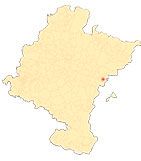Javier, a castle for a saint
Basilica (1896-1900)
At the western end of the northern polygon, at its connection with the tower of Christ, Juan de Jaso built the so-called New Palace, intended to extend and improve the residency program of the stately family inside the castle. There, in one of the chambers or rooms attached to the main conference room on the first floor, Saint Francis Xavier was born on 7 April 1506. After his beatification, a chapel was set up on the ground floor leave (1620). The disfigurement of the New Palace occurred when the chapel was extended to occupy the first and second floors leave . The construction of a dome and a vault from 1684 onwards meant that the height of the building had to be raised and the walls reinforced with buttresses. To decorate the chapel, six large canvases from the workshop of Godfrey de Maes, now in the museum, were commissioned in Flanders. Little remained of the New Palace when it was demolished at the end of the 19th century to build the present basilica.
The construction of the basilica was the personal undertaking of the restorer of the castle, María del Carmen Azlor de Aragón, 15th Duchess of Villahermosa. After some changes to the façade and the fitting of a door to the exterior (1890-1892), the duchess decided to bury her husband, the 2nd Count of Guaqui, in a luminous crypt and to build a new church, which she commissioned to Ángel Goicoechea, the architect who had restored the castle. The work was carried out between 1896 and 1900; the new church was consecrated on 19 March 1901 and shortly afterwards received the title of basilica from Pope Leo XIII. It is an eclectic building, which combined Romanesque and Gothic forms to achieve a robust church with a single nave. It is presided over by a monumental façade, with a portico, central staircase, Romanesque doorway, rose window framed by Gothic arches and a crowning body presided over by a cross.
The photo shows the interior of the basilica, which consists of three sections with ribbed vaults and a pentagonal apse, with four windows decorated with stained-glass windows depicting scenes from the life of the saint. On the side walls there are four tribunes with openwork parapets, while at the foot of the nave there is a large choir above the atrium leading to the church. The entire church is presided over by an image of Saint Francis Xavier placed in a niche and under a shrine, which is the work of the sculptor Jerónimo Suñol (1839-1902), who tried to capture the saint's passionate and tireless missionary spirit. He tried to reproduce the features with which his disciple, Fr Teixeira, described him: "Father Master Francis was rather large than small in stature, with a well-proportioned face, white and coloured, cheerful and very graceful; his eyes were black, his forehead long, his hair and beard black. His dress was poor and clean and his clothes were loose, without any mantle or other dress... He was always with his eyes fixed on heaven...". On either side of the image and under a Romanesque arch, he is accompanied by a court of honour of twelve Jesuit saints, painted in oil on panel by the Italian artist M. Capraroni.












